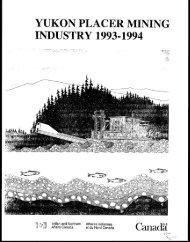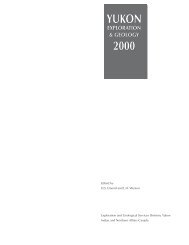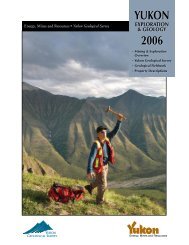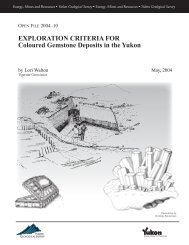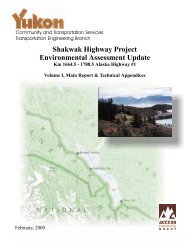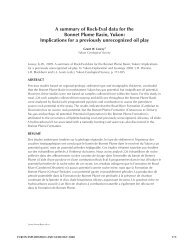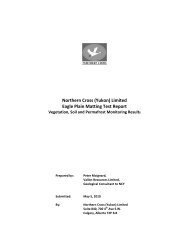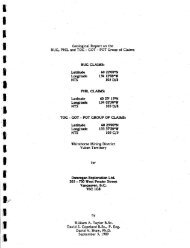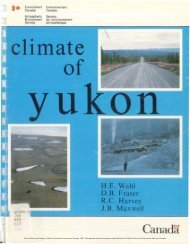WhiteCAP_Plan_01SEPT..
WhiteCAP_Plan_01SEPT..
WhiteCAP_Plan_01SEPT..
You also want an ePaper? Increase the reach of your titles
YUMPU automatically turns print PDFs into web optimized ePapers that Google loves.
NCE <strong>WhiteCAP</strong> Climate Projections<br />
Summary of Projected Climate Changes for the Whitehorse Region<br />
The effects of climate change are apparent in the Yukon. These effects represent very early<br />
evidence of the changes that climate change will have on Yukon, which are anticipated to<br />
escalate as the climate continues to warm. To assess how climate change may affect the<br />
Whitehorse area, 65 maps projecting future climate conditions were generated for use in the<br />
development of the Whitehorse Adaptation <strong>Plan</strong>. These maps project a warmer Whitehorse which<br />
experiences increased precipitation.<br />
The intention of the projections is to illustrate a conservative range of anticipated changes to our<br />
local climate over time. The projections are based on two time cuts (2030 and 2050) and two<br />
standard IPCC scenarios (B1 and A1B), presented in the Special Report on Emissions<br />
Scenarios 1 . These scenarios anticipate how various drivers (demographic development, socioeconomic<br />
development and technological change) may influence greenhouse gas emissions<br />
(GHGs). The B1 scenario projects moderate to low increases in CO2 over the next century. The<br />
A1B scenario anticipates medium to high increases in CO2 by 2100. These two scenarios were<br />
selected to provide the greatest range in possible shifts in temperature and precipitation by 2050.<br />
Projected climate changes to the Whitehorse area were generated by the Scenarios Network for<br />
Alaska <strong>Plan</strong>ning 2 (SNAP). SNAP is located at the University of Alaska-Fairbanks. The projections<br />
are based on the use of General Circulation Models (GCMs), which are complex models that<br />
anticipate how future climate may be influenced by GHGs. Because of the many variables that<br />
determine global climate and the varying ways of constructing a GCM, different GCMs perform<br />
differently, and are likely to have differing accuracy for any one region of the globe..<br />
SNAP has selected five GCMs as the basis for projecting climate change based on the work of<br />
Walsh et al 3 , which evaluated the performance of GCMs in northerly regions by comparing model<br />
back-casts to historical climate date. 15 GCMs were compared to ERA-40 (the European Centre<br />
for Medium-Range Weather Forecasts Re-Analysis) – one of the most consistent and accurate<br />
representations of temperature and precipitation. Of the fifteen evaluated models, the models<br />
ECHAM5 (Germany), CM2.1 (US), MIROC3.2 (Japan), HADCM3 (UK) and CGCM3.1 (Canada)<br />
were found to perform best over Alaska and Yukon.<br />
The GCMs were then regionally downscaled using data available from the Parameter-elevation<br />
on Independent Slopes Model (PRISM). GCMs typically have a large-scale output with grid<br />
squares between 1° and 5° in latitude or longitude (~300km 2 ). Once correlated to the GCM<br />
output, PRISM allows for a resolution of 2km 2 and accounts for regional topography.<br />
It should be noted that although SNAP models have been shown to provide valid data regarding<br />
climate trends over time, uncertainty is inherent in this type of projections. These model outputs<br />
incorporate the same degree of year-to-year variability found in real weather patterns, but cannot<br />
anticipate the timing of highs and lows.<br />
Temperature<br />
Projected mean annual temperature (MAT) and seasonal temperatures for the Whitehorse area<br />
were estimated for 2030 and 2050 using mean values from the five selected GCMs. These maps<br />
are provided below. The projections provide an estimate of anticipated increases in temperature<br />
compared to baselines established for the 1961-1990 climate normal. Annual and seasonal<br />
baseline and projected temperatures are provided in Table 1.<br />
1 http://www.ipcc.ch/pdf/special-reports/spm/sres-en.pdf<br />
2 www.snap.auf.edu<br />
3 Walsh, J.E., Chapman, W.L., Romanovsky, V., Christensen, J.H., Stendel, M. 2008. Global<br />
Climate Model Performance over Alaska and Greenland. Journal of Climate, 21: 6156-6174.<br />
E.1



